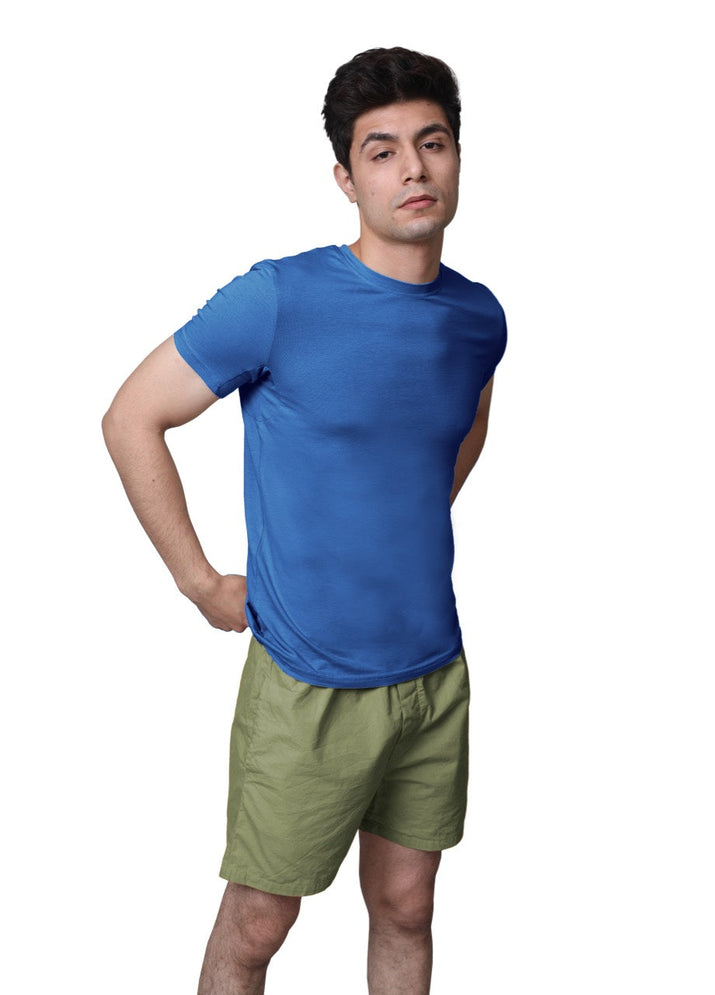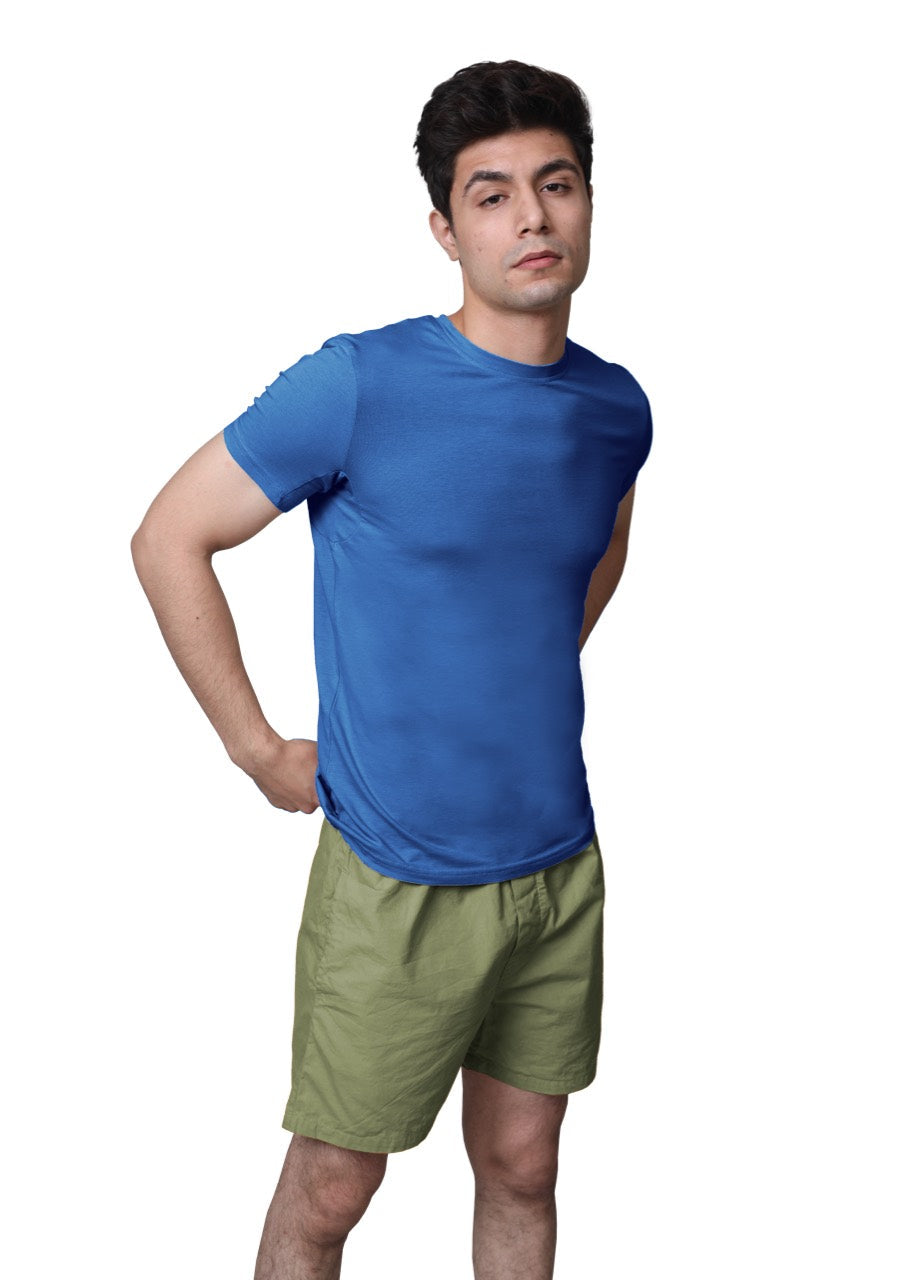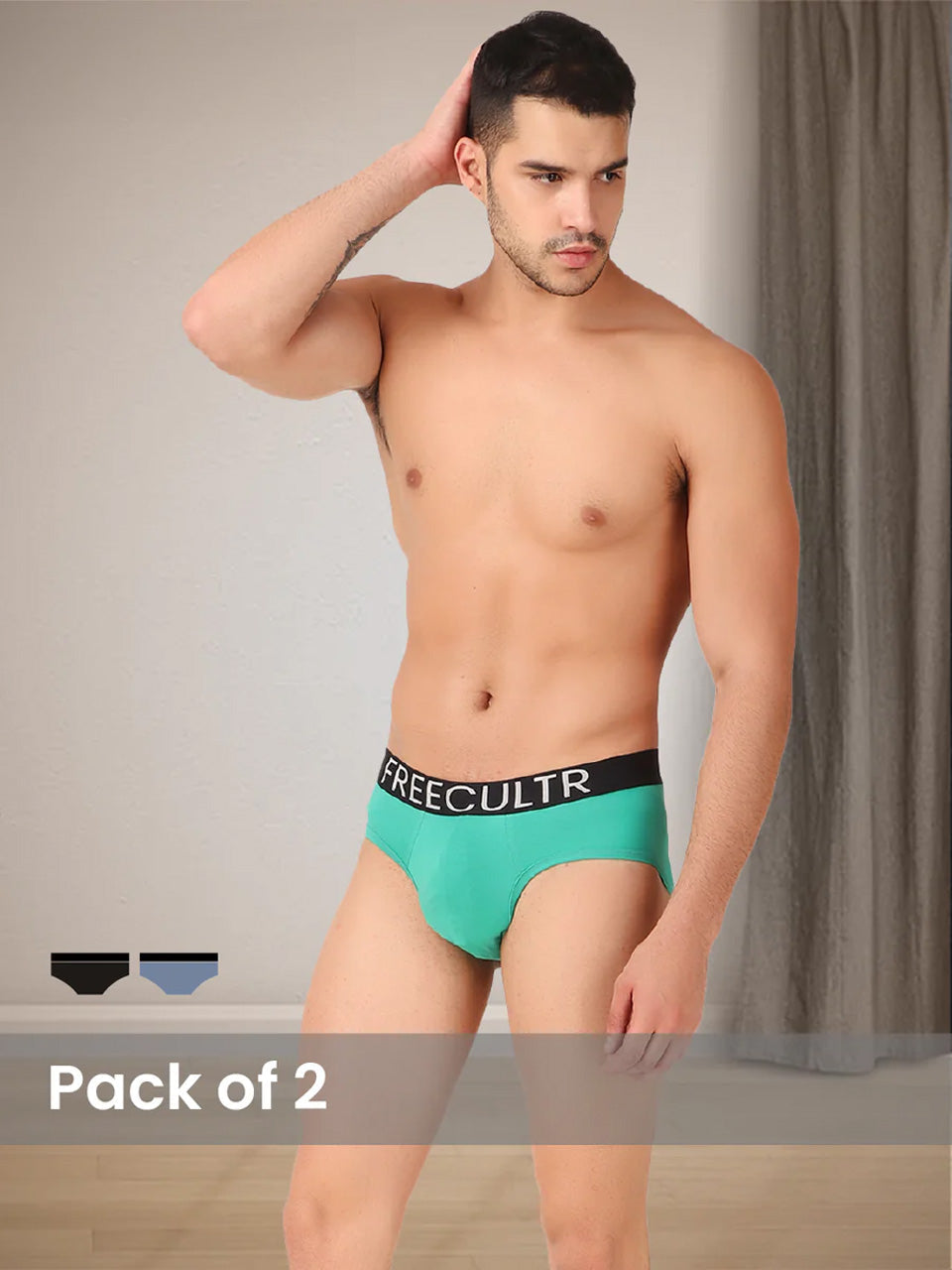Often dismissed as merely an afterthought, the humble undershirt for men quietly underpins sartorial success and all-day comfort. Beyond simply absorbing perspiration and preventing dreaded pit stains on dress shirts, modern undershirts now feature advanced fabric technologies like bamboo blends for superior breathability or micro-modal for unparalleled softness and drape. These innovations tackle common wardrobe woes, from eliminating show-through with lightweight linen shirts to providing a smooth barrier against scratchy wool sweaters and regulating body temperature for consistent comfort, a crucial factor in today's dynamic work environments. Consequently, selecting the right undershirt transforms it from a basic layer into an indispensable foundation for any well-dressed man.

Why Bother with an Undershirt? More Than Just an Extra Layer
Ever wondered if an undershirt is truly necessary? You're not alone! Many guys skip this foundational layer, thinking it's just an old-school habit. But let me tell you, a good undershirt for men is a secret weapon in your wardrobe, offering a surprising array of benefits that go way beyond just "another layer."
Think of it this way: your undershirt is the unsung hero, quietly working behind the scenes to keep you comfortable, your clothes looking sharp. Your confidence high. Here's why you should seriously consider making an undershirt a daily habit:
- Sweat Absorption and Stain Prevention This is arguably the biggest benefit. Your body naturally sweats, especially in warmer weather or stressful situations. An undershirt acts as a barrier, absorbing perspiration before it reaches your outer shirt. This prevents unsightly sweat marks (those dreaded armpit rings!) and protects your more expensive dress shirts or casual tops from sweat stains and deodorant residue over time. It's like a personal shield for your clothes!
- Protecting Your Outer Garments
- Smoothing Your Silhouette Ever put on a dress shirt only to find lumps, bumps, or the outline of your chest hair showing through? A quality undershirt for men can provide a smooth, clean canvas, creating a more polished and streamlined look. It helps drapes your outer shirt better, giving you a sharp, put-together appearance.
- Adding Warmth (or Cooling!)
- Comfort Against Scratchy Fabrics Some dress shirts, sweaters, or even casual tops can feel a bit rough or itchy against the skin. An undershirt provides a soft, comfortable barrier, making those garments much more pleasant to wear all day long.
My personal experience? I used to skip undershirts, especially in summer. Big mistake! I ended up with yellowed armpits on my white dress shirts and felt sticky and uncomfortable. Once I started wearing a good quality undershirt for men, it was a game-changer. My shirts last longer. I feel fresh even after a long day.
Decoding the Undershirt: Types of Undershirts for Men
Just like there are different types of shirts for different occasions, there are various styles of undershirts, each designed with a specific purpose in mind. Understanding these options is key to choosing the right undershirt for men for your needs.
| Undershirt Type | Description & Best Use Cases | Pros | Cons |
|---|---|---|---|
| Crew Neck | The classic, round-neck undershirt that covers the collarbone. Ideal for wearing under dress shirts with ties, crew-neck sweaters, or polos buttoned all the way up. It provides full coverage and warmth. | Versatile, traditional, offers maximum coverage and warmth, great for absorbing sweat. | Can show under open-collar shirts, might feel restrictive for some. |
| V-Neck | Features a V-shaped neckline that dips lower than a crew neck. Perfect for wearing under dress shirts or casual shirts with one or two buttons undone, as the neckline remains invisible. | Invisible under open collars, modern look, provides similar benefits to a crew neck without showing. | Less coverage around the neck/chest area, might not be as warm as a crew neck. |
| Tank Top (A-Shirt/Wife Beater) | Sleeveless shirt with wide shoulder straps. Often worn casually on its own. As an undershirt, it's best for specific situations. Provides core sweat absorption but offers no armpit protection. | Lightweight, minimal coverage, good for very warm weather or under casual open shirts, allows maximum arm movement. | Does not protect outer shirt from armpit sweat, can look informal if visible, not ideal for smoothing entire torso. |
| Long-Sleeve | An undershirt with full-length sleeves. Designed for maximum warmth and coverage, especially in colder climates or for layering under thicker garments like sweaters or jackets. | Excellent for warmth, provides full arm coverage, good for protecting sensitive skin from rough fabrics. | Can add bulk, might be too warm for mild weather, less common as a daily undershirt for men. |
| Sleeveless / Muscle Shirt | Often confused with a tank top, this typically has wider armholes and might be more structured. It's designed to be worn on its own to show off physique. As an undershirt, it offers similar benefits to a tank top but with slightly more shoulder coverage. Still, limited armpit protection. | Minimalist design, good for warm weather, can be comfortable for some under specific shirts. | Limited sweat protection in the armpit area, can look informal if visible. |
Choosing the right style of undershirt for men depends on your outer garment and the weather. For instance, if you're wearing a crisp white dress shirt with the top two buttons open, a V-neck is your best friend to avoid that tell-tale undershirt line. For a suit and tie, a crew neck is perfectly acceptable.
Material Matters: What Your Undershirt is Made Of
The fabric of your undershirt plays a huge role in its comfort, performance. Longevity. It's not just about cotton anymore! Here's a breakdown of the most common materials used for an undershirt for men and what makes them unique:
- Cotton The most traditional and widely available choice.
- Pros Soft, breathable, absorbent, relatively inexpensive. Comfortable against the skin.
- Cons
- Modal/MicroModal A type of rayon made from beechwood pulp.
- Pros Exceptionally soft (often softer than cotton), highly breathable. Has excellent moisture-wicking properties, meaning it pulls sweat away from your skin and dries quickly. It also resists shrinking and fading.
- Cons
- Bamboo Made from bamboo pulp.
- Pros Incredibly soft, naturally moisture-wicking, breathable, hypoallergenic. Has natural anti-bacterial properties (which means less odor!). It's also an eco-friendly option.
- Cons
- Synthetics (Polyester Blends, Spandex) Often used in performance or athletic undershirts.
- Pros Excellent moisture-wicking and quick-drying properties, durable. Offer stretch for a better fit (especially with Spandex). Great for active individuals or humid climates.
- Cons
- Blends Combining two or more materials (e. G. , cotton-polyester, cotton-modal).
- Pros Often offer the best of both worlds, combining the comfort of natural fibers with the performance of synthetics. For example, a cotton-modal blend provides softness, breathability. Better moisture management than pure cotton.
- Cons
When I’m advising clients on selecting an undershirt for men, I often steer them towards modal or bamboo blends. They offer superior comfort and performance, especially for long days or in warmer weather, making that initial investment truly worthwhile.
Finding Your Perfect Fit: The Undershirt Sizing Guide
A well-fitting undershirt is crucial for comfort and for it to perform its job effectively. It’s not just about picking your usual t-shirt size. Here’s what to look for to ensure your undershirt for men fits just right:
- Snug but Not Restrictive The ideal undershirt should fit close to your body without feeling tight, constricting, or causing any bunching. It should feel like a second skin, allowing for full range of motion. If it's too loose, it won't effectively absorb sweat or smooth your silhouette. If it's too tight, it will be uncomfortable and potentially show lines under your outer shirt.
- Length for Tucking
- Armhole and Shoulder Fit For sleeved undershirts (crew neck, V-neck, long-sleeve), the armholes should not gape open, nor should they dig into your armpits. The shoulder seams should ideally align with the edge of your shoulders. For tank tops, ensure the straps are wide enough to cover your bra straps (if applicable) and don't dig in.
- Neckline Considerations
- Crew Neck Should sit comfortably around the base of your neck without feeling tight or loose.
- V-Neck
A good test is to put on the undershirt, then your outer shirt. Look in the mirror. Are there any visible lines? Does it feel comfortable when you move? If you see wrinkles or feel constriction, you might need a different size or style. Remember, the goal is invisibility and comfort.
Undershirt Etiquette: When and How to Wear Them
Knowing which undershirt for men to wear and when is key to maximizing its benefits and avoiding fashion faux pas. It's all about strategic layering!
- Under Dress Shirts This is where the undershirt truly shines.
- With a Tie A crew neck undershirt is perfectly fine and provides maximum coverage.
- Open Collar (1-2 buttons undone)
- White or Light-Colored Dress Shirts For these, consider "invisible" undershirts, which are often light grey or skin-toned. White undershirts can actually show through white dress shirts due to contrast. A grey or skin-toned undershirt blends better with your skin tone, making it less visible.
- Under Sweaters/Knits An undershirt provides a comfortable barrier against potentially itchy wool or synthetic blends. A crew neck or V-neck works well, depending on the sweater's neckline. Long-sleeve undershirts are great for added warmth.
- Under T-Shirts
- Layering for Warmth In colder weather, an undershirt (especially a long-sleeve one) forms a crucial base layer. It traps heat close to your body, adding significant warmth without bulk. This is particularly useful under flannels, thicker shirts, or as the first layer under a sweater and jacket combination.
- The "Invisible" Undershirt Concept
My advice to anyone asking about undershirts: think of it as part of your outfit's foundation. It should support, protect. Enhance, never distract. The right undershirt for men disappears, leaving only a polished impression.
Caring for Your Undershirt: Longevity Tips
Your undershirt works hard, so treating it well ensures it lasts longer and continues to provide comfort and protection. Proper care is essential to maintain the fabric's integrity, absorbency. Fit.
- Washing Instructions
- Check the Label Always, always check the care tag first. Different materials have different needs.
- Separate Whites and Colors
- Cold Water is Your Friend Washing in cold water helps prevent shrinking, fading. Preserves the fabric's elasticity, especially for cotton and modal blends.
- Gentle Cycle
- Mild Detergent Use a mild detergent to avoid harsh chemicals that can break down fibers over time. Avoid excessive bleach, especially on colored or blended undershirts.
- Drying Tips
- Air Dry When Possible The best way to prolong the life of any undershirt, particularly those made of modal, bamboo, or blends, is to air dry them. Hang them on a line or lay them flat. This prevents heat damage, shrinking. Maintains their shape.
- Low Heat Tumble Dry
- When to Replace
- Stains If your undershirt has persistent yellowing (especially in the armpits) or other unremovable stains, it's time to let it go. These stains can often show through your outer shirt.
- Loss of Shape
- Thinning Fabric/Holes Obvious signs of wear, such as thinning fabric, small holes, or frayed seams, indicate it's no longer serving its purpose optimally.
Think of your undershirt for men as an investment in your comfort and your wardrobe. A little care goes a long way in keeping them in top condition.
Addressing Common Undershirt Myths
There are a few persistent myths about undershirts that often lead guys to dismiss them without understanding their true value. Let's bust these myths wide open!
-
Myth 1: "Undershirts make you hotter."
- Reality While adding a layer might seem counterintuitive in warm weather, a good undershirt for men, especially one made from moisture-wicking materials like modal, bamboo, or performance synthetics, can actually help you stay cooler. How? By drawing sweat away from your skin, allowing it to evaporate more efficiently. This evaporation is your body's natural cooling mechanism. Without an undershirt, sweat can sit on your skin or saturate your outer shirt, making you feel clammy and hotter.
-
Myth 2: "They're just for old guys or formal wear."
- Reality This couldn't be further from the truth! While undershirts have been a staple for generations, modern undershirts are designed with contemporary style and performance in mind. They're worn by men of all ages, from stylish young professionals to active outdoorsmen, precisely because of their practical benefits in comfort, hygiene. Garment protection. They're just as relevant under a casual button-down as they are under a suit.
-
Myth 3: "You don't need one if you wear a T-shirt."
- Reality As discussed in the "Etiquette" section, you generally avoid an undershirt under a casual t-shirt to prevent visible lines. But, the myth implies that a t-shirt itself provides all the benefits of an undershirt. It doesn't. A t-shirt is designed as an outer garment, often thicker and less absorbent in the key areas (like armpits) than a dedicated undershirt. A t-shirt also doesn't provide the same smooth base for other layers, nor does it typically protect your outer shirt from sweat and oils as effectively as a proper undershirt for men. For instance, a thin white t-shirt worn alone can still show sweat marks and get stained much faster than if you had an undershirt beneath it.
Hopefully, debunking these myths helps you see the undershirt for men in a new light – as an indispensable, modern wardrobe essential, not an outdated accessory.
Conclusion
The humble undershirt, often overlooked, is truly the unsung hero of men's wardrobes, providing that foundational layer of comfort and confidence. Gone are the days of scratchy, ill-fitting options; modern developments in fabrics like bamboo and modal offer unparalleled breathability and a smooth drape that enhances the look of your outer garments. I've personally found that investing in a quality, well-fitting undershirt, especially one with moisture-wicking properties, makes a tangible difference in my all-day comfort, whether I'm navigating a humid commute or spending hours in a formal setting. So, make it a point to evaluate your current collection; consider upgrading to a performance blend for active days or a seamless, lightweight option to disappear under your dress shirts. Embrace this essential layer. Experience the subtle yet profound improvement in your daily comfort and overall presentation.More Articles
Inner Wear – Unrestricted Movement & Gentle SupportInner Wear – Foundation of Comfort & Confidence
Men's T-shirt – Everyday Comfort & Perfect Fit
Men's T-shirt – Versatile Layering & Modern Style
Men's T-shirt – Classic Style & Soft Feel
FAQs
Why bother with an undershirt?
Undershirts do a lot more than you might think! They act as a protective barrier between your skin and outer clothing, helping to absorb sweat, prevent stains. Keep your dress shirts or tops looking fresh. Plus, they add an extra layer of warmth when it's cool and can even make your clothes drape better.
What's the biggest benefit of wearing one all day?
The biggest benefit is definitely all-day comfort and freshness. An undershirt wicks away moisture, preventing sweat marks from showing on your outer shirt and keeping you feeling drier. It also stops outer fabrics from feeling scratchy against your skin and can reduce chafing.
Are there different kinds of undershirts?
Absolutely! The most common styles are crew neck (round neck), V-neck. Tank top (or A-shirt). Each is designed for different outer shirt necklines. You'll also find various fabric blends, like cotton for breathability, synthetic blends for moisture-wicking. Even some with added stretch for comfort.
How do I pick the right undershirt for my outfit?
It mostly comes down to your outer shirt's neckline and how much you want the undershirt to show. For crew neck shirts or sweaters, a crew neck undershirt works well. If you're wearing an open-collar shirt or a V-neck, a V-neck undershirt is best so it stays hidden. Consider the fabric too – a thin, breathable one is great for hot days, while a slightly thicker one adds warmth.
Will an undershirt make me feel hotter?
Not necessarily. While it adds a layer, many modern undershirts are designed with breathable, moisture-wicking fabrics that actually help regulate your body temperature. By drawing sweat away from your skin, they can help you feel cooler and drier, especially compared to having sweat saturate your outer shirt.
Can I just wear an undershirt on its own, like a regular tee?
Generally, no. Undershirts are typically designed to be worn under other clothes. They're often thinner, sometimes sheerer. Cut differently than a regular t-shirt. While you could wear one on its own, it might not look as polished or intentional as a proper t-shirt designed for outer wear.
How often should I replace my undershirts?
That depends on how often you wear and wash them. A good rule of thumb is every 1-2 years. Look for signs like yellowing (especially in the armpits), thinning fabric, stretched-out necklines or armholes, or if they just don't feel as comfortable or supportive anymore. Quality undershirts can last longer with good care.






